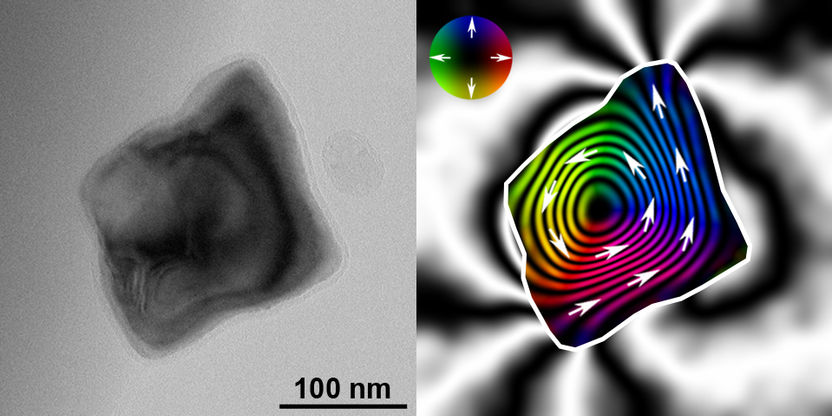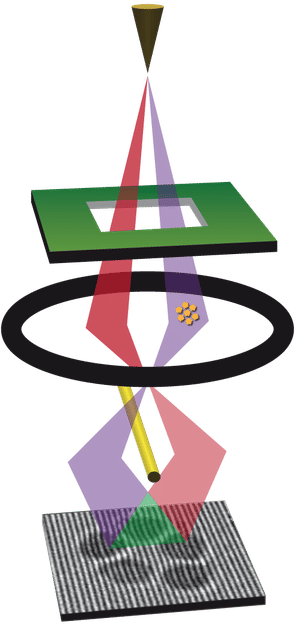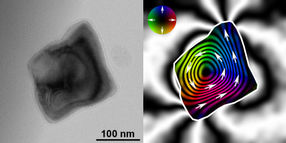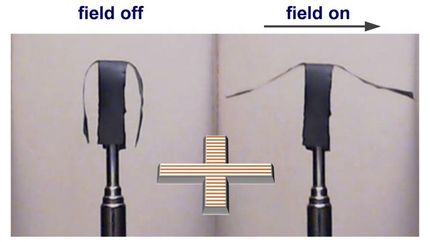Magnetic Vortices Defy Temperature Fluctuations
Common Magnetic Mineral is Reliable Witness to Earth's History
Advertisement
Magnetic nanovortices in magnetite minerals are reliable witnesses of the earth's history, as revealed by the first high-resolution studies of these structures undertaken by scientists from Germany and the United Kingdom. The magnetic structures are built during the cooling of molten rock and reflect the earth's magnetic field at the time of their formation. The vortices are unexpectedly resilient to temperature fluctuations, as electron holographic experiments in Jülich have verified. These results are an important step in improving our understanding of the history of the earth's magnetic field, its core and plate tectonics.

Electron microscopy image of a magnetite nanocrystal (left) and the magnetic vortex structure (right), made visible for the first time by researchers from Jülich and the United Kingdom using electron holography.
Copyright: Imperial College London

In the process of electron holography, the electron beam in the microscope is split in two. One part serves as a reference; the second is directed through the sample and collects information about its magnetic structure. Both electron beams together create an interference pattern containing the information in an encrypted form. Analysis of the recorded hologram is necessary to allow conclusions to be drawn about the magnetic fields in the specimen.
Copyright: Forschungszentrum Jülich


The earth's magnetic field performs important functions: it protects us, for example, from charged particles from space and enables migratory birds, bees, and other animals to navigate. However, it is not stable, and constantly changes its intensity and state. Several times in the past it has even reversed its polarity – the north and south poles have changed places. Scientists in the area of paleomagnetism use magnetic minerals to investigate the history of the earth's magnetic field and its formation from molten metal flowing within the earth's core, the so-called geodynamo. Furthermore, the movement of continental plates can be monitored with the aid of such rocks.
In the course of millions of years, these minerals could often have been exposed to immense temperature fluctuations, due to extreme climate change or volcanic activity, for instance. How well do the magnetic structures survive such temperature fluctuations and how reliable is the information gained from them? An international research team has now studied this question for the first time at ultra-high resolution on samples of magnetite, the mineral dominating the magnetic properties in the earth's crust. "It is only in a small part of naturally occurring magnetite that magnetic structures known for being very stable with respect to temperature fluctuations are found," explains Dr. Trevor Almeida of Imperial College London. "Far more common are tiny magnetic vortices. Their stability could not be demonstrated until now."
Together with colleagues from Forschungszentrum Jülich, the University of Edinburgh and the University of Nottingham, Almeida has studied the magnetic vortices in magnetite nanocrystals. As the structures are so tiny – each grain is only about the size of a virus – there is only one method with which the nanovortices can directly be observed while they are heated up and cooled down: "A special high-resolution electron microscope at the Ernst Ruska-Centre (ER-C) in Jülich is capable of making magnetic fields on the nanoscale holographically visible," explains Almeida. "In this way, images of field lines are produced almost like using iron filings around a bar magnet to make its magnetic field visible, but with a resolution in the nanometre range."
The experiments in Jülich showed that although the magnetic vortices alter in strength and direction when heated up, they go back to their original state as they cool down. "Therefore magnetite rocks, which carry signs of temperature fluctuations, are indeed a reliable source of information about the history of the earth," enthuses Almeida.
"Electron holography has made it possible for us to gain a completely new insight into the magnetic behaviour of magnetite," emphasized Prof. Rafal Dunin-Borkowski, Director at the ER-C and at the Peter Grünberg Institute in Jülich. As an expert in electron holography, he works with his Jülich team on further improving the resolution of this technique and in providing German and international scientists the necessary infrastructure to perform this type of study. "Weak magnetic fields in nanocrystals don't just play a role in paleomagnetism. In information technology, for instance, electron holograms can also be of use to help to push back the physical limits of data storage and processing."



























































